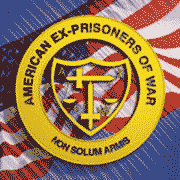
Established April 14, 1942
 |
American Ex-Prisoners of War
A not-for-profit, Congressionally-chartered veterans’ service organization advocating for former prisoners of war and their families.
Established April 14, 1942 |
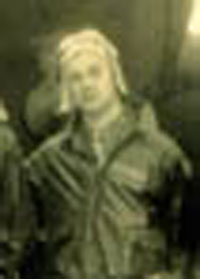 |
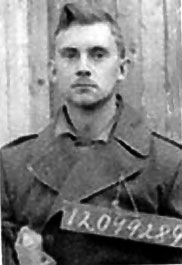 |
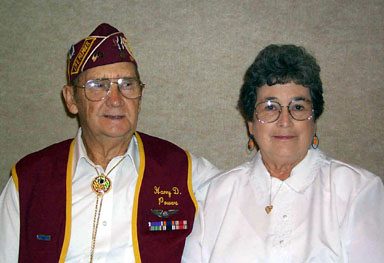
Harry and Ginny D. Powers, Baton Rouge Nat. Convention, 1998
|
| Last Name | First Name, Middle Init. | Nickname |
| Street Add. | City | State |
| Zip | Spouse | |
| Conflict | Branch of Service | Unit: |
| Theatre of Operation | Military Job | Where Captured |
| Date Captured | Time Interned | Camps |
| Date Liberated | Medals Received | Age at Capture |
| After the War ... | ||
On July 21, 1942 I said my good-byes to family and my girl Ginny in upstate NY and enlisted in the Army Air Force . I was shipped to Keesler Field, MS. Boy! Was it hot there for a Yankee like me.
I completed aircraft mechanic school by December and was promptly shipped to Seattle, WA for training on the B-17, along with my good friend Eddie Pearce, who was to play an important role in my life. After completion of training we were shipped to Las Vegas, NV for gunnery school. By this time I should have had a hint to where we were headed -- but we took things one day at a time. I think it was some time in March 1943 when we finished gunnery school and was shipped to Salt Lake City, UT where we were interviewed and I was asked if I would like to go for Cadet Pilot training. I thought it would be a step up the ladder so said ok.
They sent me to a pool to wait to be shipped out. I waited a week and nothing happened so I got itchy and asked to be sent on to where all my friends had gone. They cut my orders for Ephrata, WA. When I got there all my friends from previous schools were there, including my buddy Ed Pearce. Finally they started making up bomber crews. I met my pilot, co-pilot navigator and bombardier. They were all nice guys.
I was 22 at the time, and both pilots were only 20. They made me 1st engineer; Eddie Pearce, 2nd engineer; Ray Leveille, lst radio operator; Cecil Holliday, ball turret gunner; George Jahnke, the left waist gunner; and Fred Smart, the tail gunner. The average age of our crew was 20 years-old.
Believe me, 1st phase training can be a KILLER. We lost several crews before we advanced to 2nd phase training at Geiger Field, WA. At Geiger we started the famous 390th Bomb. Group. After the war it became the 390th Missile Group based at Tucson, AZ. We earned two Presidential citations -- one for the October 14 Schweinfurt Raid.
Third phase training was accomplished at Great Falls, MT during the month of June 1943. At the beginning of July we were scheduled to go overseas to England. We were to fly our planes to Salina, Kansas: have a six day furlough to get home and be back and have a new plane waiting for us to fly overseas. When we returned we found we still had old 991, the plane we started with in 2nd phase training -- an early F Model. We did have four new engines. We loved that old plane. It was built on Boeing jigs and flew real well. A couple of days later we left Salina for Bangor, ME. We got a call by radio that the weather was bad over Bangor and to land at Syracuse, N.Y. My girl Ginny was living there and I had just given her an engagement ring while I was home -- so I got to see her again.
After Syracuse we flew to Bangor where someone cut our de-icing boots even with a guard on duty. I taped them up with masking tape and we flew to Gander, Newfoundland where they were repaired. A couple of days later we took off for Scotland. I remember topping off the gas tanks three times to be sure we had enough fuel. We took off about 5:00 p.m. About 2:00 a.m. our navigator got one "three star" fix. About 7:00 a.m. he said we should be over the coast of Ireland. We dropped down through the overcast and there IT WAS! What a beautiful sight. We landed at Prestwick, Scotland. We stayed there a couple of days before going on to Framlingham, England. While in England we had lots of more training -- gunnery, formation flying, etc.
The first mission was Bonn, Germany on August 8, 1943. Our pilot was stricken with a medical problem and we had to return to base. After that they made our co-pilot 1st pilot, and we waited awhile to get a replacement co-pilot. When we started flying again these missions followed:
We hadn't named our plane yet, but after about three missions we decided to call her "PATCHES" for all the flak and bullet holes she sustained. In the briefing of the morning of Schweinfurt, they said: "They know you are coming . GOOD LUCK! If you knock out the target you will shorten the war by six months."
We were delayed by fog that morning. We were the lead ship carrying the bomb sight. Right after we dropped our bombs we sustained three direct hits with flak. We lost two engines and one shell went right through #2 wing tank leaving a stream of gas behind us. As I transferred gas and manned the top turret fighting off l09's we were drifting back. Then we caught fire and had to bail out.
During the process I was hit in the right shoulder by a piece of flak. When I bailed out my chute jerked me so hard that when I landed I could not walk. I was immediately captured and carried to a tool house that they locked me in. Some time later they came with a truck and picked me up. I was glad to see the rest of my crew had all survived. On that day we lost sixty out of one hundred bombers.
I was put in a field hospital a couple of days to be sure nothing was broken I was given crutches and sent to Dulag Luft. I was put in isolation for ten days and interrogated constantly -- gave the name, rank and serial number despite their threats.
Later I was sent to Stalag 17B at Krems, Austria. I think the uncertainty of what the next day would bring, along with the starvation, cold temperatures, fleas, and the second Christmas of still being there and constant threats of being shot was the worst. We dug a few tunnels but somehow the guards always found out about them, so there were no escapes. We were there for twenty months until our eighteen-day march west to Braneau, Austria. We were liberated on April 5th by Gen. George Patton. My weight was down to about 114 pounds -- we were always HUNGRY. At Camp Lucky Strike they tried to build us up with frequent feedings.
I caught a plane to England and went back to my old base to see my crew chief. It seems he waited on the flight line til well after dark waiting for us to come back. Col. VonArb came out and got him and told him we didn't make it. He was very glad to hear we all survived after twenty months. I asked if I could get a ride home on a plane. The C.O. said sure if you want to go to Japan. I said "No thanks" and caught a hospital ship home from Southhampton, England.
I married Ginny on August 4, 1945.
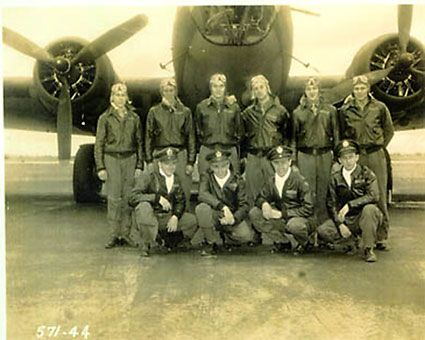
Front row -- Fernie McEwin,co-pilot; Harold Erickson, pilot; Victor Baker, navigator; Vincent McDonald, bombardier Second row -- Cecil Holliday, radio operator and ball turret gunner; Ray Leville, 1st radio operator; Edwin Pearce, assistant engineer and right waist gunner; Harry Powers, engineer and top turret gunner; George Jahnke, 1st armored and left waist gunner; Fred Smart, tail gunner |
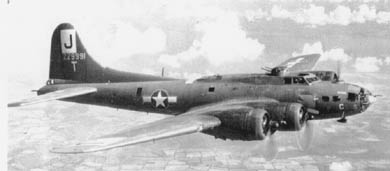
"Patches" (B-17 Flying Fortress) |